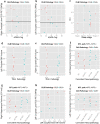Clinical and multimodal biomarker correlates of ADNI neuropathological findings
- PMID: 24252435
- PMCID: PMC3893373
- DOI: 10.1186/2051-5960-1-65
Clinical and multimodal biomarker correlates of ADNI neuropathological findings
Abstract
Background: Autopsy series commonly report a high percentage of coincident pathologies in demented patients, including patients with a clinical diagnosis of dementia of the Alzheimer type (DAT). However many clinical and biomarker studies report cases with a single neurodegenerative disease. We examined multimodal biomarker correlates of the consecutive series of the first 22 Alzheimer's Disease Neuroimaging Initiative autopsies. Clinical data, neuropsychological measures, cerebrospinal fluid Aβ, total and phosphorylated tau and α-synuclein and MRI and FDG-PET scans.
Results: Clinical diagnosis was either probable DAT or Alzheimer's disease (AD)-type mild cognitive impairment (MCI) at last evaluation prior to death. All patients had a pathological diagnosis of AD, but only four had pure AD. A coincident pathological diagnosis of dementia with Lewy bodies (DLB), medial temporal lobe pathology (TDP-43 proteinopathy, argyrophilic grain disease and hippocampal sclerosis), referred to collectively here as MTL, and vascular pathology were present in 45.5%, 40.0% and 22.7% of these patients, respectively. Hallucinations were a strong predictor of coincident DLB (100% specificity) and a more severe dysexecutive profile was also a useful predictor of coincident DLB (80.0% sensitivity and 83.3% specificity). Occipital FDG-PET hypometabolism accurately classified coincident DLB (80% sensitivity and 100% specificity). Subjects with coincident MTL showed lower hippocampal volume.
Conclusions: Biomarkers can be used to independently predict coincident AD and DLB pathology, a common finding in amnestic MCI and DAT patients. Cohorts with comprehensive neuropathological assessments and multimodal biomarkers are needed to characterize independent predictors for the different neuropathological substrates of cognitive impairment.
Figures





References
-
- Thies W, Bleiler L. 2013 Alzheimer's disease facts and figures. Alzheimers dement j Alzheimers Assoc. 2013;1:208–245.
Publication types
MeSH terms
Substances
Grants and funding
LinkOut - more resources
Full Text Sources
Other Literature Sources
Medical
Molecular Biology Databases

